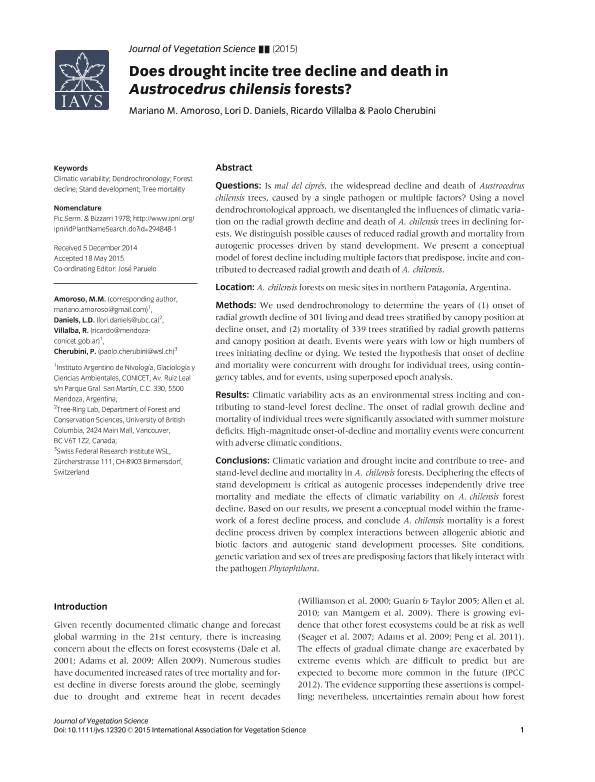Artículo
Does drought incite tree decline and death in Austrocedrus chilensis forests?
Fecha de publicación:
11/2015
Editorial:
Wiley Blackwell Publishing, Inc
Revista:
Journal of Vegetation Science
ISSN:
1100-9233
Idioma:
Inglés
Tipo de recurso:
Artículo publicado
Clasificación temática:
Resumen
Questions: Is mal del ciprés, the widespread decline and death of Austrocedrus chilensis trees, caused by a single pathogen or multiple factors? Using a novel dendrochronological approach, we disentangled the influences of climatic variation on the radial growth decline and death of A. chilensis trees in declining forests. We distinguish possible causes of reduced radial growth and mortality from autogenic processes driven by stand development. We present a conceptual model of forest decline including multiple factors that predispose, incite and contributed to decreased radial growth and death of A. chilensis. Location: A. chilensis forests on mesic sites in northern Patagonia, Argentina. Methods: We used dendrochronology to determine the years of (1) onset of radial growth decline of 301 living and dead trees stratified by canopy position at decline onset, and (2) mortality of 339 trees stratified by radial growth patterns and canopy position at death. Events were years with low or high numbers of trees initiating decline or dying. We tested the hypothesis that onset of decline and mortality were concurrent with drought for individual trees, using contingency tables, and for events, using superposed epoch analysis. Results: Climatic variability acts as an environmental stress inciting and contributing to stand-level forest decline. The onset of radial growth decline and mortality of individual trees were significantly associated with summer moisture deficits. High-magnitude onset-of-decline and mortality events were concurrent with adverse climatic conditions. Conclusions: Climatic variation and drought incite and contribute to tree- and stand-level decline and mortality in A. chilensis forests. Deciphering the effects of stand development is critical as autogenic processes independently drive tree mortality and mediate the effects of climatic variability on A. chilensis forest decline. Based on our results, we present a conceptual model within the framework of a forest decline process, and conclude A. chilensis mortality is a forest decline process driven by complex interactions between allogenic abiotic and biotic factors and autogenic stand development processes. Site conditions, genetic variation and sex of trees are predisposing factors that likely interact with the pathogen Phytophthora.
Archivos asociados
Licencia
Identificadores
Colecciones
Articulos(CCT - PATAGONIA NORTE)
Articulos de CTRO.CIENTIFICO TECNOL.CONICET - PATAGONIA NORTE
Articulos de CTRO.CIENTIFICO TECNOL.CONICET - PATAGONIA NORTE
Articulos(IANIGLA)
Articulos de INST. ARG. DE NIVOLOGIA, GLACIOLOGIA Y CS. AMBIENT
Articulos de INST. ARG. DE NIVOLOGIA, GLACIOLOGIA Y CS. AMBIENT
Citación
Amoroso, Mariano Martin; Daniels, Lori D.; Villalba, Ricardo; Cherubini, Paolo; Does drought incite tree decline and death in Austrocedrus chilensis forests?; Wiley Blackwell Publishing, Inc; Journal of Vegetation Science; 26; 6; 11-2015; 1171-1183
Compartir
Altmétricas




